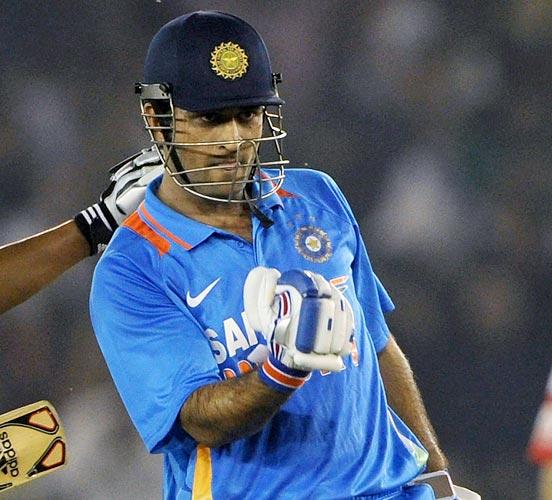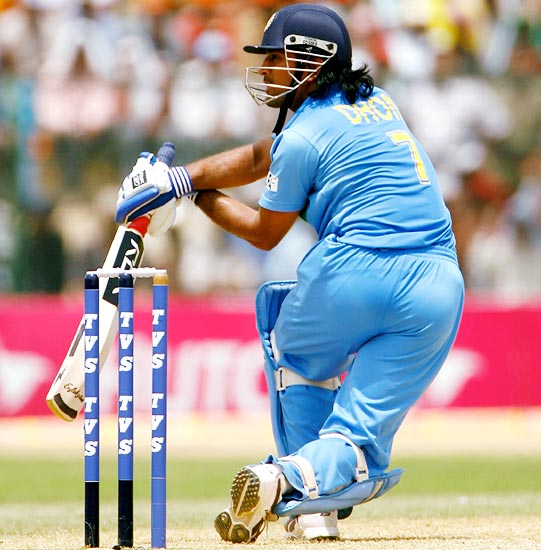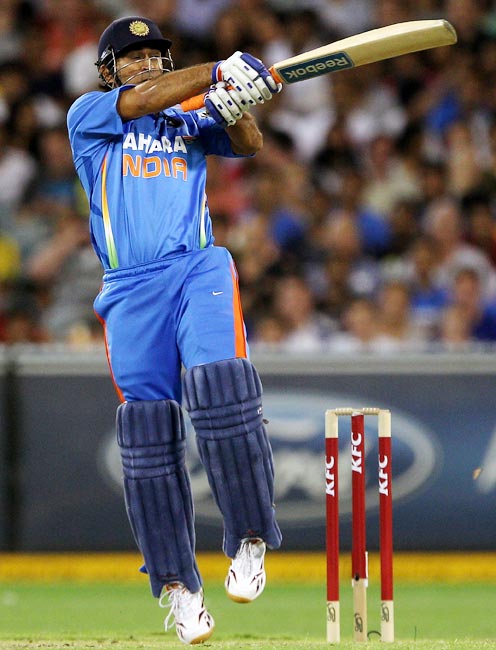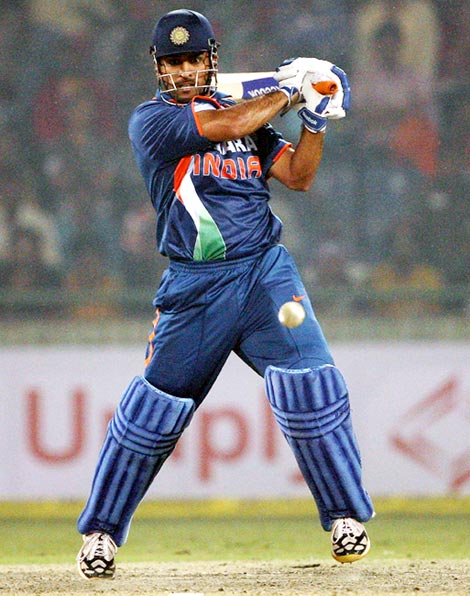Photographs: Getty Images
Is Mahendra Singh Dhoni the best finisher in limited-overs' cricket?
As a batsman who averages more than 100 in successful run chases, India's captain certainly qualifies as one of the most reliable batsman when it comes to the closing stages of a One-Day International.
- Wish Yuvraj Singh a speedy recovery
Time and again he's proved that nothing fazes him in a tight run-chase, or when the going gets tough.
Against Australia, in the fourth match of the CB tri-series on Sunday, Dhoni displayed his prowess yet again as he guided India home with an unbeaten knock of 44, hitting a huge six in the final over as the tourists scored the required 13 runs and won with two balls to spare.
Who can forget his magical knock against Sri Lanka in the World Cup final last year, the icing on the cake being the six that clinched victory.
A look at Dhoni's top five innings in India's successful run chases:
...
When Dhoni's six won India the World Cup!
Photographs: Getty Images
91 not out vs Sri Lanka at Mumbai on April 2, 2011
He led from the front with the bat in the final and helped India win the coveted World Cup after a long wait of 28 years!
Batting first, Sri Lanka posted a mammoth total of 277, leaving India to score a record total, as they faced the highest ever chase in the final.
- Images: World Cup win at the Wankhede
And when India lost both their openers, Virender Sehwag and Sachin Tendulkar, to speedster Lasith Malinga early on, the task got even more daunting.
Gautam Gambhir and Virat Kohli steadied the ship, adding 81 runs for the third-wicket, before the latter was dismissed in the 22nd over.
The game was still up for grabs for both teams before Dhoni took the gamble of promoting himself ahead of the in-form Yuvraj Singh (he batted mostly at number 6 or 7 in the World Cup).
As he later revealed, it was done to counter the Muttiah Muralitharan spin threat, which Dhoni was very familiar, being his team-mate at Chennai Super Kings in the Indian Premier League (IPL).
Partnering the left-handed Gambhir, he also ensured a right-left combination at the crease, which made it difficult for the bowlers to settle into a rhythm. The move turned out to be a master-stroke, as Dhoni and Gambhir steadied the innings and kept up with the required run-rate with some good stroke-play and aggressive running between wickets.
Dhoni started slowly, but later accelerated with a flurry of boundaries, finishing with 91 not out off 79 balls.
Befitting the occasion, he finished the match with a huge six over long-on, off bowler Nuwan Kulasekara, to bring the Cup home.
The turning point in Dhoni's career
Photographs: Getty Images
183 not out vs Sri Lanka at Jaipur on October 31, 2005
A target of 299 is never easy to chase, but Dhoni produced the kind of innings that made everyone forget the task on hand and concentrate his magic.
He bludgeoned his way with some amazing stroke-play, one of the best ever seen in cricket. The innings perhaps proved the turning point in Dhoni's career and give it the perfect platform.
- Modest Dhoni leads by example for expectant India
Bowlers, whether they were pacers or spinners, left-armers or right-arm bowlers, wrist spinners or finger spinners, all of them were just praying that Dhoni would not hit them for a big six. It was that sort of a day for Dhoni at the Sawai Man Singh Stadium; almost every delivery he hit went a long way.
Chaminda Vaas, known to be both miserly and mean, was smashed over the extra-cover boundary for two sixes in what was just the beginning of a long assault. In fact, the total of 10 sixes from Dhoni was the maximum by an Indian by far and the highest by a wicketkeeper.
The previous highest of 172 was held by Adam Gilchrist.
Dhoni was also very close to breaking another record by Sachin Tendulkar (186 not out, highest by an Indian then), but, alas, the Sri Lankans had not scored enough runs!
One can well imagine the scene at the multi-purpose ground, where the crowd sat a good 20 meters away from the ropes, but could still see the ball come to them every now and then.
Dhoni slammed 15 fours, apart from those 10 sixes, for a tally of 120 runs from just boundaries. The second highest score was a mere 39, scored by Virender Sehwag, in such a huge run chase.
The final six came when two were needed for a win; but with almost four over still to go, there was no doubt in anyone's mind that he would have got past the world record (then) of 11 sixes, held jointly by Sanath Jayasuriya and Shahid Afridi.
When Yuvraj played second fiddle to Dhoni
Photographs: Getty Images
72 not out vs Pakistan, Lahore, February 13, 2006
After being asked to bat, Pakistan's innings was tottering at one stage, but they finally ended with 288 for 8, thanks to Shoaib Malik's 108 and Abdul Razzaq's unbeaten 64.
The Indian innings got early jolts with the departure of Gautam Gambhir and Irfan Pathan. Sachin Tendulkar was at his blistering best, scoring 95 off 104 balls, but it was the partnership between Dhoni and Yuvraj Singh that turned the game on its head; the duo added 102 runs in just 13 overs. Dhoni did the bulk of the damage, scoring 73 percent of the runs scored off the bat in the partnership as Yuvraj was content to play the second fiddle.
Dhoni was aggressive, but seldom did he take any risk. When the bowlers pitched it up, he played with the full face of the ball, ensuring minimum risk. When the bowlers pitched it short, he unveiled some fierce pull shots, and the game ended in a hurry.
He remained unbeaten on 72, off just 46 balls, that included 13 fours.
Dhoni at the end of a famous victory again!
Photographs: Getty Images
44 not out vs Australia, Adelaide, February 12, 2012
India had lost to Australia in the four previous games at Adelaide and had never chased down a target of 250 or more against the hosts in Australia. So, a winning target of 270 looked out of their reach.
For a change, the opening pair of Gambhir and Sehwag gave India a solid start. Sehwag's dismissal was followed by in-from Kohli's, but Gambhir and Rohit Sharma kept up the momentum with some good intelligent cricket in the middle overs.
But Rohit threw his wicket away at a crucial juncture, and a few overs later Gambhir was adjudged leg before wicket on 92. The game was in balance as Australia started to dry up the runs.
Dhoni struggled to find his touch when he came in to bat, and with every passing over the pressure started mounting on him as he was unable to pierce the field.
In fact, during the Batting Powerplay, he consumed 13 dot balls and looked out of place.
India needed 73 runs off the last 10 overs, and 40 in the last five. In the penultimate over, only four runs came and India lost the important wicket of Ravindra Jadeja.
13 runs were needed off the last over and it seemed Dhoni had delayed things far too long.
Only one run came off Clint McKay's first two balls. With 12 needed off last four balls and the game slipping away from India's grasp, Dhoni picked a length delivery from outside off and dispatched it over long-on for a massive six. It was a remarkable hit under the circumstances.
The hit made the bowler, McKay, panic and he bowled a waist-high full-toss off the next ball, which was caught by Warner on the boundary, but India got three precious runs as the ball was signalled a no-ball. The next ball was hit for three and India had registered their biggest chase on Australian soil. And, yes, Dhoni was there at the end of a famous victory, yet again.
Dhoni kept his nerve to take India to a memorable win
Photographs: Getty Images
46 not out vs West Indies, Gros Islet, July 3, 2009
In a game of fluctuating fortunes, Dhoni kept his nerve to take India to a memorable win.
The game was shortened by rain and the West Indies scored 186 for 7 in 27 overs.
India were set a revised target of 195 in 27 before a further shower revised it to 159 in 22 overs.
India had the game in their control, but a flurry of wickets left them requiring 34 in four overs. It came down to the last over, with India needing 11.
Dhoni held fort despite wickets falling regularly from the other end. It was any body's game, but he swiped the second ball from pacer Jerome Taylor over the midwicket boundary to seal the match.
He and Yusuf Pathan got the remaining four runs with a ball to spare.







Comment
article